1997 CHEVROLET S10 wheel
[x] Cancel search: wheelPage 15 of 402

Downloaded from www.Manualslib.com manuals search engine Your vehicle has a light that
comes
on as a reminder to
buckle
-up. (See “Safety
Belt Reminder Light”
in
the Index.)
In most states and Canadian -provinces, the law says to
wear safety belts. Here’s why: They work.
You never how .if you’ll be.in a crash. If you do have a
crash, you don’t how if it will be
a bad one.
A few crashes are mild, and some crashes can be so
serious that even buckled up a person wouldn’t survive.
But most crashes
are in between. hmany of them,
people
who buckle up can survive and sometimes walk
.away. Without belts
they could have been badly hurt
or killed,
After more than
25 years of safety belts in vehicles,
the tacts are clear. In most crashes buckling up does
matter
. . . a lot!
Why Safety Belts Work
Wen you ride in or on anythmg, you go as fast as it .goes.
T& the. simplest-vehicle. Suppose it’s just a seaton wheels.
1-8
Page 28 of 402
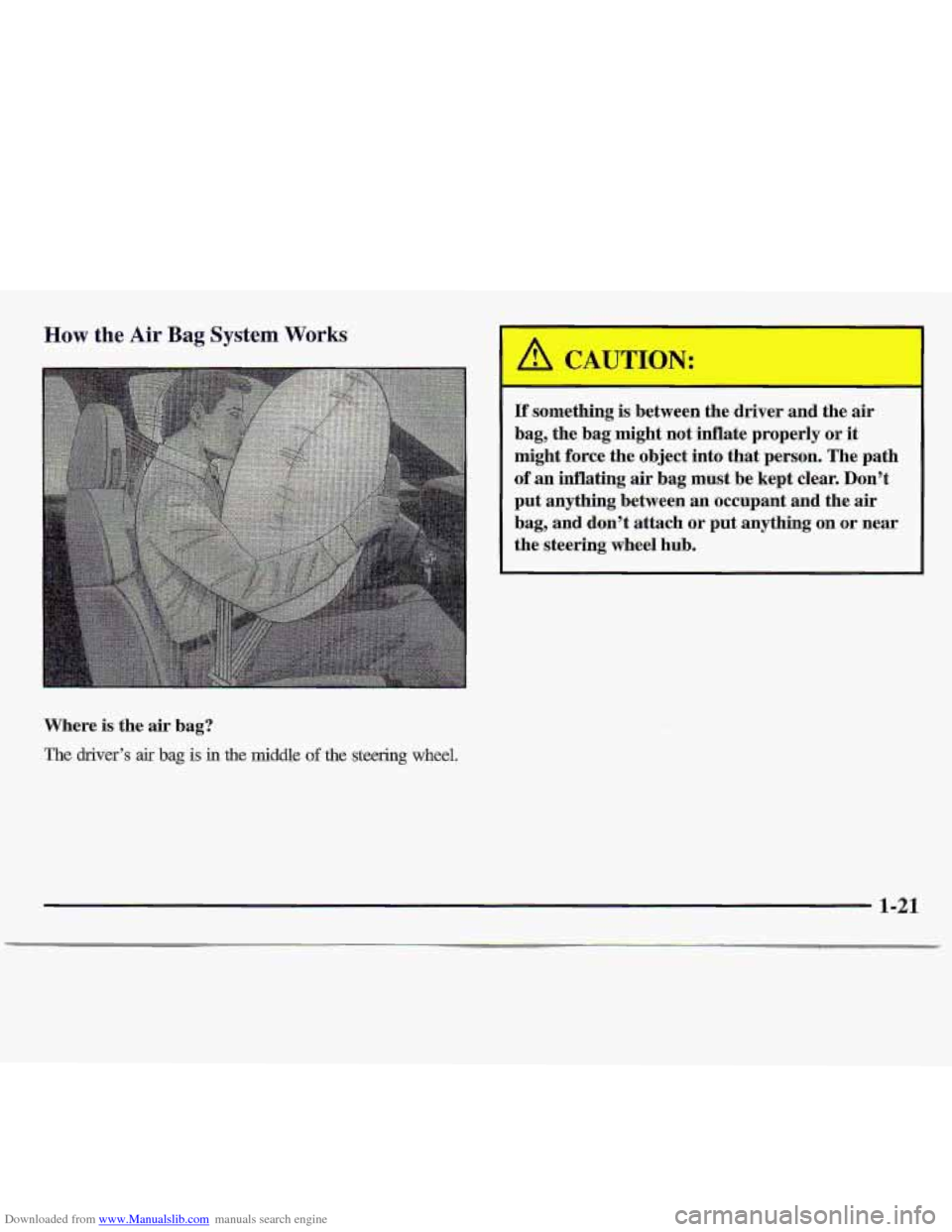
Downloaded from www.Manualslib.com manuals search engine How the Air Bag System Works
Where is the air bag?
The driver’s air bag is in the middle of the steering wheel.
If something is between the driver and the air
bag, the bag might not inflate properly
or it
might force the object into that person. The path
of an inflating .air bag must be kept clear. Don’t
put anything between
an occupant and the air
bag, and don’t attach
or put anything on or near
the steering wheel hub.
1-21
Page 30 of 402

Downloaded from www.Manualslib.com manuals search engine What wiil you see after an air bag inflates?
After an air hag inflates, it quickly deflates, so quickly
,that some people may not even realize the air b-ag
inflated. S'orne components of the air bag mo'dule in the
steering
wheel hub will be hot fd a short time. The parts
of the bag that come.into contact with you may be
warm, but not, too. hot to. t.ouch. Thew wi11 be some
-smoke and,dust-coming from vents in the-deflatd air
bag. Air bag inflation doesn't prevent the driver from
s.eeing
orfrbom beilzg able to steerthe vehicle, nor does it
stoppeople
from le-aving .the vehicle.
I
When an air bag inflates,. there is dust in the air.
This dust could cause breathing problems for
people-
with a history of asthma or other
breathing trouble..
To avoid this, .everyone in the
vehicle should get out as
-soon as it is safe to do so.
If you have breathing problems.but can't get out
of the vehicle after an air bag inflates, then get
fresh air
by opening a window or door.
NOTICE:
If you damage the cover for the driver's air bag,
the bag may not work properly. You may have: to
rep1ac.e the air bag module. Do not open or break
'the -air bag cover.
1-23
Page 48 of 402
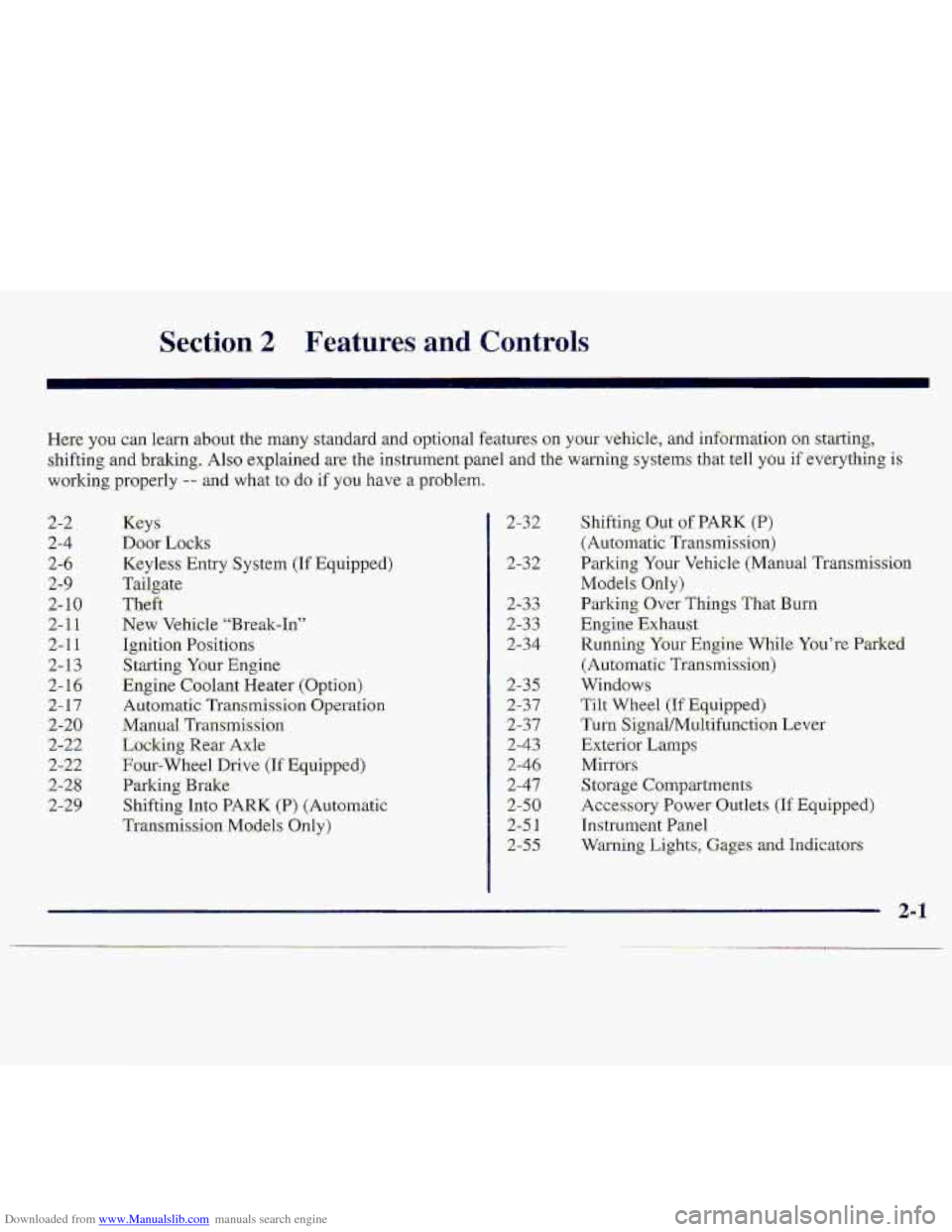
Downloaded from www.Manualslib.com manuals search engine Section 2 Features and Controls
Here y~u can learn about the many standard and opti-onal features o.n your-vehide, and irkofmation on starting,,
shifting
and braking. Also explained are the instrument panel and, the warning systems that teil you if everything is
working properly -- and what to do if you have a problem.
Keys
Door L.ocks
Key1e.s~ Entry 'System- (If Equipped)
Tailgate
Theft
Ne.w Vihicle "Break-In"
Ignition Positions
S.tarting
You Engine
Engine Coolant Heater (Option)
htqmatic. Tr.ansmission Operation
Manual Trmsrnissio,n
Locking Rear Axle:
Four-wheel Drive (If Equipped)
Parking Brake.
Shi€ting
Into PARK (P) (Automatic
Transmission
Ma.dels Only)
2-32
2-52
2-33
2-3 3
2-34
2-35
2-3 7
2-37
2-43
2,-47
2-50
2-5 1
2-55
2-4-6;
Shifting Out of PARK (P)
(Auto'mmtic Transmission)
Parking
Your Vehicle (Manual Transmission
Models Only)
Parlung Qve.1- Things That Burn
.Engine
Exhaust
Running Your EQg-ine While YGu're Parked
(Automatic Transmission)
Windows
Ti it Wheel (If Equipped)
Turn Signal/Multi~~ncti-on- Lever
Exterior Lamps
'3 t-orage Compartments
Accessory
Power Outlets (If Equipped)
Tnstrument Panel
Warning
Lights; Gap .and Tndicatms
2-1
Page 57 of 402
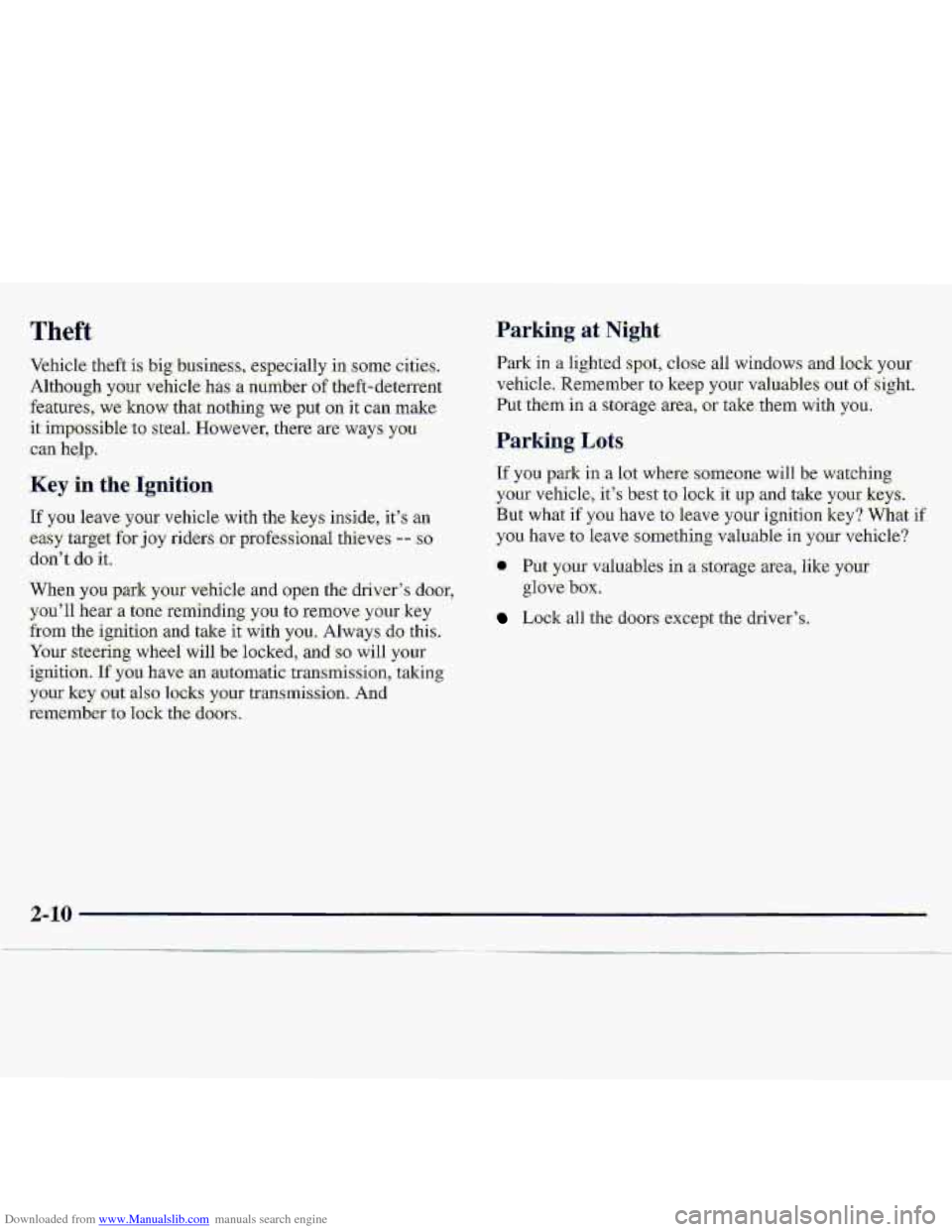
Downloaded from www.Manualslib.com manuals search engine Theft, Parking at Mght
Vehicle theft isbig Business, especially in.some cities,
Although your vehicle has a number of theft-detefren’t
-features, we know that nothin-g we put on
it can make
it.impassible
to steal. However, there’ are- ways you
.ean.bqlp.
Key in the Ignition
If you leave your vehicle with the keys inside, it’s; an
easy target for Joy riders or professional thieve-s -- .so
don’t .do it.
When you. park your-vehicle and open the driver’s dam,
you’ll he;rr a tone remiding you to remove your key
from the ignitipo and take it with you. Always do this.
Your steering wheel will be locked, and so will your
ignitkm: If you have an automatic tr-arcmission, taking
your key out also lacks your msmis.sian. And
remember to
lack.thc doors.
P&k in a lighted spot, close all windows and 1.ock.your
vehicle.. Remember to keep your valuables .out of sight.
Put .them in a storage are&
6.r take them with .you.
Parking .. Lots,
‘If you pafk in a lot where:someone will be watching.
your vehicle, it’s be:st
to lgck it up-and take ywr keys.
But what if you have to-leave your ignition key? What if
YOU have to leave something. valuable in your vehicle?
0. Put your vxl-luables i.n a. st;or.age. area, like your
glove
box.
Lock all the doors except the driver’s.
2-10
Page 58 of 402
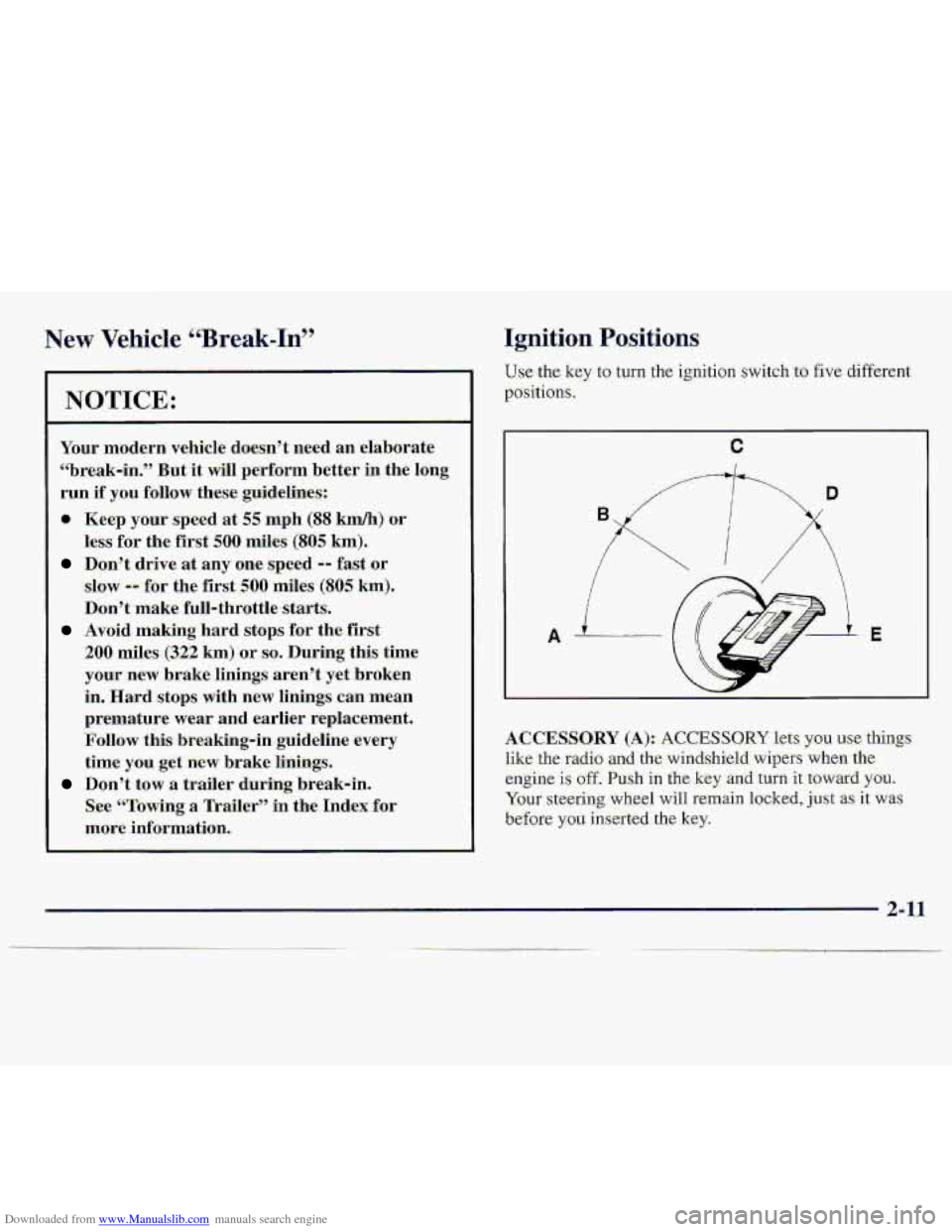
Downloaded from www.Manualslib.com manuals search engine New Vehkk “Bre-ak-In”
NOTICE:
Your modern vehicle d.oesn’t need an elaborate
“break-in.”
But it will perform better in the long
run if you follow these guidelines:
0 Keep your speed at 55 mph (88 km/h) or
less far the first 500 miles (805 km).
Don’t drive at any one speed -- fast or
slow
-- for the first-500 miles (805 km).
Don’t make full-thro.ttle starts.
200 miles. (322 km) or so. During this time
your
new brake linings aren’t yetbro-ken
in. Hard stops with new linings cmmean
premature wear and earlier replacement.
Follow this breaking-in guideline every
time you
get new brake linings.
See “Tbwing a Trailer” in the Index for
more information..
Avoid makiilg hard stops for the first
Don’ttow a trailer during break-in.
Ignition Positions
Use.the key to-turn the ignition switch to €ive different
positions,
A 3.
ACCESSORY (A):. ACCESSO-RY lets ysu .use‘-thi-ngs
like the radio ad the.winds,hield wipe-rs when the
engine is off. Push i.n the key -and turn it toward. YOU.
Your steering wheel will remain locked, just. as it was
before
you inserted the. key.
2-11
Page 59 of 402
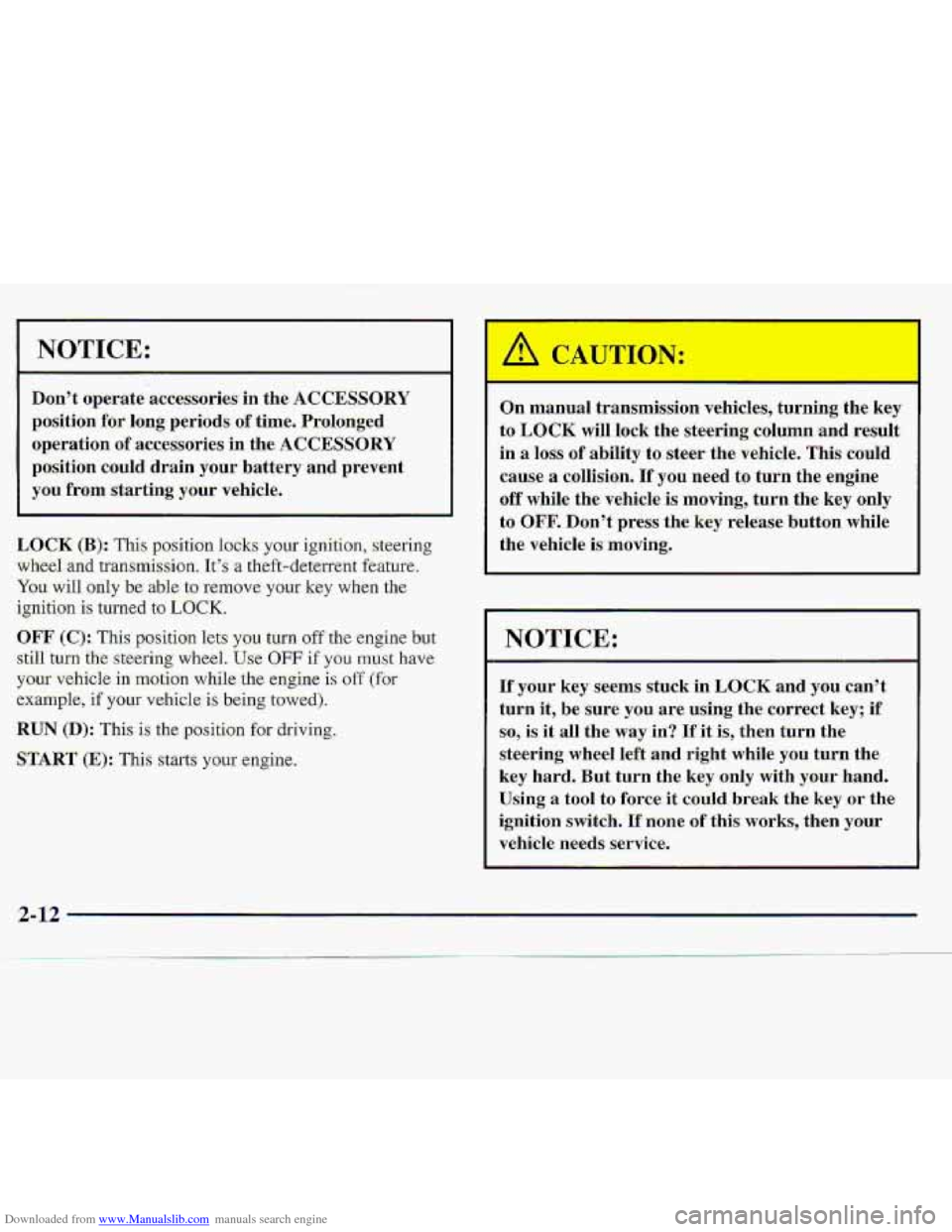
Downloaded from www.Manualslib.com manuals search engine NOTICE:
Don't operate accessories. in the ACCESSORY
position far long periods of time. Prolonged.
operation
of accessories in the ACCESSORY
position could drain your battery-and prevent
you
from skarting your vehicle.
LOCK (E): This position locks your ignition; -steering
wheel-and tra-nsmiss-ion.
It's a theft-deterfeat feature.
You will oaly be able to remove your key whe.n the
ignition is turned to. LOCK.
.OFF (C); This position lets you turn off.the engine but
Tstill turn the steering wheel'. Us.e OFF if you must have
~yx.u- whic1.e in motion while -the erigine :is off (for
example, if your vehickis being towed).
RUN (I)): This is the positio-n for driving.
START (E): This starts your engine. On manual transmission
vehicles, turning t.he key
to
LOCK will lock the steerihgcolumn and result
in
a lass of ability to steer the vehicle. This could
cause
-a collision. If you need to turn the enghe
off while the vehicle is moving, turn the key only
to OFF. Don't press the key release button while
the vehicle is moving.
NOTICE:
If your key seems stuck in 'LOCK. and -you can't
turn it, be sure you
are using the corkect key; if
so, is it all the way in? If'ft is, then turn the
steering wheel left and right while you turn the
key h.ard. But t.urn the key only with
your hand.
Using
a tool to force it could. break the key or the
ignition switch.
'If none of this. works, then your
vehicle needs service.
2-12
Page 64 of 402

Downloaded from www.Manualslib.com manuals search engine Automatic Transmission Operation
Your automatic transmission may have a shift lever
located
on the console between the seats or on the
steering column.
There are several different positions for your shift lever.
If your vehicle is equipped with a column shift lever,
it
features an electronic shift position indicator within the
instrument cluster. This display must be powered
anytime the shift lever is capable of being moved out
of
the PARK (P) position. This means that if your key is in
the
OFF position, but not locked, there will be a small
current drain
on your battery which could discharge
your battery over a period of time.
If you need to leave
your key in the ignition
in the OFF position for an
extended period, it is recommended that you disconnect
the battery cable from the battery
to prevent discharging
your battery.
PARK (P): This locks your rear wheels. It’s the best
position to use when you start your engine because your
vehicle can’t move easily.
Lf! C A TION:
It is dangerous to get out of your vehicle if the
shift lever is not fully in
PARK (P) with the
parking brake
firmly set. Your vehicle can roll.
Don’t leave your vehicle when the engine is
running unless you have to.
If you have left the
engine running, the vehicle can move suddenly.
You or others could be injured.
To be sure your
vehicle won’t move, even when you’re on fairly
level ground, always set your parking brake and
move the shift lever to
PARK (P).
If you have four-wheel drive, your vehicle
will be free to roll
-- even if your shift lever
is in
PARK (P) -- if your transfer case is in
NEUTRAL (N). So, be sure the transfer case is in
a drive gear, two-wheel high (2HI) or four-wheel
high (4HI) or four-wheel low (4LO)
-- not in
NEUTRAL (N). See “Shifting Into PARK (P)” in
the Index.
If you’re pulling a trailer, see “Towing
a Trailer’’ in the Index.
2-17